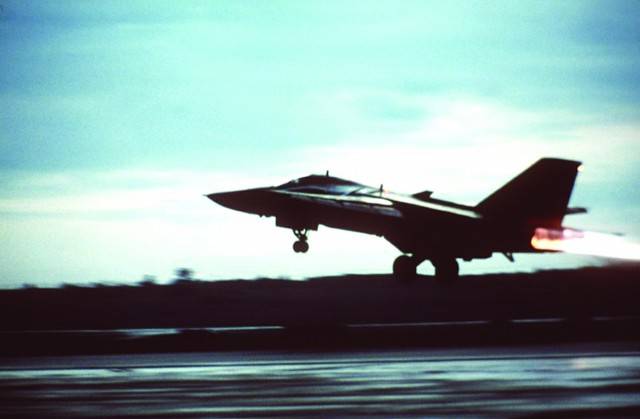
This photograph shows a 48th Tactical Fighter Wing F-111F aircraft retracting its landing gear as it takes off from RAF Lakenheath, East Anglia England, to participate in a retaliatory air strike on Libya
On April 14, 1986, the United States launched air strikes against Libya in retaliation for the Libyan sponsorship of terrorism against American troops and citizens. The raid involved more than 100 U.S. Air Force and Navy aircraft, and was over within an hour. Five military targets and “terrorism centers” were hit, including the headquarters of Libyan leader Muammar al-Qaddafi.
During the 1970s and ’80s, Qaddafi’s government financed groups worldwide, from Palestinian guerrillas and Philippine Muslim rebels to the Irish Republican Army and the Black Panthers. In response, the U.S. imposed sanctions against Libya, and relations between the two nations steadily deteriorated. In 1981, Libya fired at a U.S. aircraft that passed into the Gulf of Sidra, which Qaddafi had claimed in 1973 as Libyan territorial waters. That year, the U.S. uncovered evidence of Libyan-sponsored terrorist plots against the United States, including planned assassination attempts against U.S. officials and the bombing of a U.S. embassy-sponsored dance in Khartoum, Sudan.
On April 14, the United States struck back with dramatic air strikes against Tripoli and Banghazi. The attacks were mounted by 14 A-6E navy attack jets based in the Mediterranean and 18 FB-111 bombers from bases in England. Numerous other support aircraft were also involved. France refused to allow the F-111Fs to fly over French territory, which added 2,600 total nautical miles to the journey from England and back. Three military barracks were hit, along with the military facilities at Tripoli’s main airport and the Benina air base southeast of Benghazi. All targets except one were reportedly chosen because of their direct connection to terrorist activity. The Benina military airfield was hit to preempt Libyan interceptors from taking off and attacking the incoming U.S. bombers.
Even before the operation had ended, President Reagan went on national television to discuss the air strikes. “When our citizens are abused or attacked anywhere in the world,” he said, “we will respond in self-defense. Today we have done what we had to do. If necessary, we shall do it again.”
Operation El Dorado Canyon, as it was code-named, was called a success by U.S. officials. Qaddafi’s 15-month-old adopted daughter was killed in the attack on his residence, and two of his young sons were injured. Although he has never admitted it publicly, there is speculation that Qaddafi was also wounded in the bombing. Fire from Libyan surface-to-air missiles and conventional anti-aircraft artillery was heavy during the attack, and one F-111, along with its two-member crew, were lost in unknown circumstances. Several residential buildings were inadvertently bombed during the raid, and 15 Libyan civilians were reported killed. The French embassy in Tripoli was also accidentally hit, but no one was injured.

On April 14, 1986, the United States launched air strikes against Libya in retaliation for the Libyan sponsorship of terrorism against American troops and citizens. The raid involved more than 100 U.S. Air Force and Navy aircraft, and was over within an hour. Five military targets and “terrorism centers” were hit, including the headquarters of Libyan leader Muammar al-Qaddafi.
During the 1970s and ’80s, Qaddafi’s government financed groups worldwide, from Palestinian guerrillas and Philippine Muslim rebels to the Irish Republican Army and the Black Panthers. In response, the U.S. imposed sanctions against Libya, and relations between the two nations steadily deteriorated. In 1981, Libya fired at a U.S. aircraft that passed into the Gulf of Sidra, which Qaddafi had claimed in 1973 as Libyan territorial waters. That year, the U.S. uncovered evidence of Libyan-sponsored terrorist plots against the United States, including planned assassination attempts against U.S. officials and the bombing of a U.S. embassy-sponsored dance in Khartoum, Sudan.
On April 14, the United States struck back with dramatic air strikes against Tripoli and Banghazi. The attacks were mounted by 14 A-6E navy attack jets based in the Mediterranean and 18 FB-111 bombers from bases in England. Numerous other support aircraft were also involved. France refused to allow the F-111Fs to fly over French territory, which added 2,600 total nautical miles to the journey from England and back. Three military barracks were hit, along with the military facilities at Tripoli’s main airport and the Benina air base southeast of Benghazi. All targets except one were reportedly chosen because of their direct connection to terrorist activity. The Benina military airfield was hit to preempt Libyan interceptors from taking off and attacking the incoming U.S. bombers.
Even before the operation had ended, President Reagan went on national television to discuss the air strikes. “When our citizens are abused or attacked anywhere in the world,” he said, “we will respond in self-defense. Today we have done what we had to do. If necessary, we shall do it again.”
Operation El Dorado Canyon, as it was code-named, was called a success by U.S. officials. Qaddafi’s 15-month-old adopted daughter was killed in the attack on his residence, and two of his young sons were injured. Although he has never admitted it publicly, there is speculation that Qaddafi was also wounded in the bombing. Fire from Libyan surface-to-air missiles and conventional anti-aircraft artillery was heavy during the attack, and one F-111, along with its two-member crew, were lost in unknown circumstances. Several residential buildings were inadvertently bombed during the raid, and 15 Libyan civilians were reported killed. The French embassy in Tripoli was also accidentally hit, but no one was injured.


